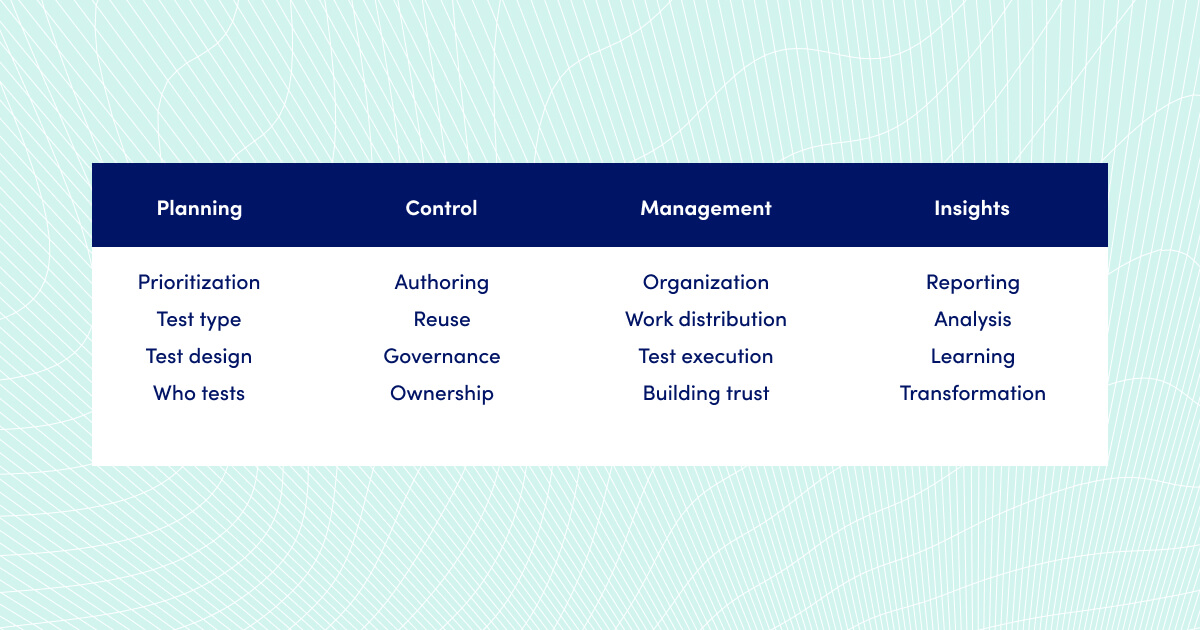
Quality is everything. But many organizations fail to deliver it consistently with each application release to their customers. Why?
Organizations might now be aware that when it comes to software development testing, they need to ensure test coverage of the continuous application releases. For small teams, it is enough to ensure the complete test coverage by picking the right test automation tools and cooperating closely with both the development and operations teams. However, for larger teams, it is quite challenging to keep track of the test coverage. This is because they rely heavily on test automation frameworks, tools and processes and run them with CI/ CD integration with pipelines. They need to have visibility into all the test automation operations and report generation for later analysis.

What is TestOps – a definition
This is why they need TestOps. It is a software development framework that test and validates software continuously, i.e. at all levels. It not only integrates all of the automated tests in the CI/CD pipeline but also it allows you to maintain the whole lifecycle of a given product.
The correct definition of TestOps (as it is sometimes understood incorrectly as running critical test scenarios in production) is that it is a discipline of managing testing operations in order to scale test coverage, empower people and make testing activities more efficient. It does so through focusing on consistent quality and delivery speed.
TestOps spans across all testing activities so that both smaller and larger teams can better plan their testing execution, organize and control their testing runs and gain valuable insight that drive continuous improvement for future releases.
TestOps covers mobile testing, web application testing as well as API testing. And the TestOps framework is compatible with tools such as Selenium, Docker, BrowserStack, etc. This is because its aim is to make the test as robust as possible and maintain track of the testing coverage with the lowest rate execution time. TestOps makes it possible to detect failures early in the development process so that the team can react, respond and fix any issues as quickly as possible.

How does TestOps work in practice?
The task of the operations team is to monitor all the testing processes and assess the product quality. Through performing continuous testing, they aim to achieve high(er) customer satisfaction. In TestOps this is an additional aspect of the tester skills set.
The TestOps includes the following points:
Step 1: Preparation of test data to be used in testing
Step 2: Testing that includes the specific testing types:
- Integration Testing
- Automation Testing
- Security Testing
- Performance Testing
- Accessibility Testing
3) Utilizing CI/ CD knowledge to validate all the continuing processes.
There are also 4 primary areas of focus for TestOps methodology. These are:
- Real-time dashboards
- Cloud-based automation testing
- Treating non-functional testing as essential.
- API testing
TestOps features
TestOps offers a sustainable and controllable software delivery ecosystem thanks to its features.
If you are wondering what TestOps is in practice, you need to know its capabilities, too.
These include:
- DevOps integration: QA engineers tend to rely on the pipelines without much input. These are usually put together by IT. TestOps changes this by owning test activities that are related to DevOps. This way, QA engineers and developers can have full ownership of the development pipeline so that it is flexible and can be tailored to meet their software development needs. TestOps also ensures that by DevOps integration, the product development pipeline contains all the required testing frameworks and tools.
- Enhanced test planning: TestOps provides a unified and centralized platform for testes and developers. They can easily decipher what tests need to be executed, when the test runs are taking place, etc. TestOps makes test automation simply more effective this time – the entire codebase does not have to be retested once a single line of code changes.
- Lower execution time: with TestOps, developers can leverage the benefits of test automation. It allows for much less complex manual testing and enables developers to make better use of their testing environments.

- Test coverage (zero-bug policy): the zero-bug policy resolves the defects raised during production at any point during the team sprint. The bug is evaluated and fixed or it might get closed if it is not customer-impacting. TestOps test each functionality thoroughly – all so that there are no issues at the build time.
- Continuous Integration and Framework: in TestOps, the continuous improvement implies that teams keep track of any code that is committed to the repositories by means of triggers.
- Speed delivery vs. quality: the double focus of TestOps is both at the speed of delivery of a new product as well as on its quality. A very common problem that the tester faces is that the high-quality standards might need to be compromised to speed up the delivery. Or the project takes too long so that the customers get a bug-free product.
TestOps offers faster delivery through faster testing of each of the features and functionalities. Test automation should be carried out in the pipeline. This way, the regression tests find all the defect in the software (and it all happens in a timely manner).

How does TestOps compare?
In order to understand better how TestOps work, it might be helpful to understand how the other software testing methodologies work.
How does TestOps compare then with other trending technologies that are commonly used in software development and testing?
Waterfall:
This is the oldest software development lifecycle model. And it is still in use in many companies. The advantage of the Waterfall approach is that because of its rigidity, it is simply to understand and manage. Each phase contains specific deliverables and milestones are easy to follow.
However, rigidity also means not enough flexibility in terms of making room for changes. If any feature was not included in the initial requirements, it was difficult to adjust the Waterfall model to change this. Also, there was no way for customers to have a peek at the emerging product. They had to wait until the very end of the development cycle. This also meant that – contrary to DevOps – the bugs were only found later on and businesses had to spend additional money to fix them.
Agile:
Agile showed up as an alternative to Waterfall that at some point, was considered not flexible enough. With Agile methodology, you get multiple development phases (called sprints). Each sprint is a separate step to: collect requirements, plan testing activities and work, code, test and release the product. This means developing software happens gradually. This gives the customers the opportunity to give feedback and recommendations regarding any changes or adding any necessary features for future sprints.
DevOps:
DevOps brought a major improvement to Agile as it enables collaboration between the development and operations teams early on in the development cycle. DevOps by doing so shortens the product delivery time and enable organizations to deliver products faster. In spite of the speedy delivery of good quality software, however, there is still an issue with the increased level of testing which calls for scaling up of testing projects.
And this is where TestOps comes into play. It coordinates and automates activities during the development lifecycle. The main difference between DevOps and TestOps is that the former ensures that there is a proper environment for test execution, the latter provides a fully automated testing approach.

What does TestOps consist in?
Test coverage, the team size, its skills diversity and also the size, complexity and requirements of your application – they all dictate what capabilities you will need for your software development journey
You can distinguish several fundamental capabilities that TestOps delivers. What are they?
PLANNING:
Planning in TestOps covers prioritization but also all test types and test design. Planning starts very early on but it should also continue throughout the development lifecycle. This is where teams prioritize tests based on their criticality, risk, complexity, current coverage, etc. TestOps planning identifies and prioritizes what requires testing, how it will be tested (including the testing environment), what are the test’s overall objectives, and who is responsible for executing each test. Everyone can collaborate on mapping out a document with all the testing requirements and decisions – stakeholders, quality team members, etc.
MANAGEMENT:
With TestOps management, you can ensure that all the testing processes are efficient and scalable. The management phase dictates which test should be prioritized and how the teams should conduct testing – who will be responsible for specific tests, etc. The responsibilities also include setting up name conventions, establishing rules for organizing tests and deciding on the test owners for test cases that fail so that they address the errors on time. TestOps tools enhance visibility and collaboration in each of those areas. It prevents getting any flaky tests, helps increase team’s confidence in the tests and manage them to high(er) standard.

CONTROL:
The control phase with TestOps is all about setting standards for conducting tests. For a code review, you should involve individuals with a thorough knowledge of the program who can make sure that there are no issues that could cause any bugs. For larger teams, you also need testing subject matter experts in order to guide the team members on how to use the test automation tools efficiently, reuse the existing testing components and avoid any bottlenecks in the process. TestOps also allows for change control processes such as required reviews that standardize how the team handles the testing functions so that they can set some best practices, too.
INSIGHTS:
This components relates to all the information that is collected during testing. Insights helps the testing and development teams to understand better the nitty-gritty of the project: they get to assess the release readiness, gauge project quality, measure team’s effectiveness during each development iteration and check if the quality standards have been met.
TestOps insights help the team to make continuous improvements so that they can streamline processes and save time through elimination of recurring problems during the next product release. Also, thanks to the fact that the information is collected at each step of the testing run, the teams get more clarity as to what has gone wrong and if the product is indeed ready for a release.
An important part of the Insight phase is the TestOps analysis which gives information about improvements in the testing process.. It involves review of different aspects of the testing operations, such as performance, stability, failure diagnostics,
How to get started in TestOps?
The best option is to kick off by integrating the automation testing throughout the software development lifecycle. By connecting the DevOps and the testing functions, you get continuous feedback between those areas. Plus, your organization can utilize this to organize and manage tests, test requirements and integration better – all in one space.
Also, involve every team in the project so that they can access any tools or integrations. The development platform should be accessible to anyone to collaborate – developers, testers and other IT personnel, too.
The automation framework should include properly built tests. Ideally, project teams should incorporate testing at each and every part of the DevOps pipeline. For this, you need a well-defines testing strategy, too – from test requirements to software build. Such an approach will definitely prevent any bugs from popping up once the product is finished and ready for go-live. And this, looking long-term, will help secure and save the budget set for the software project.
